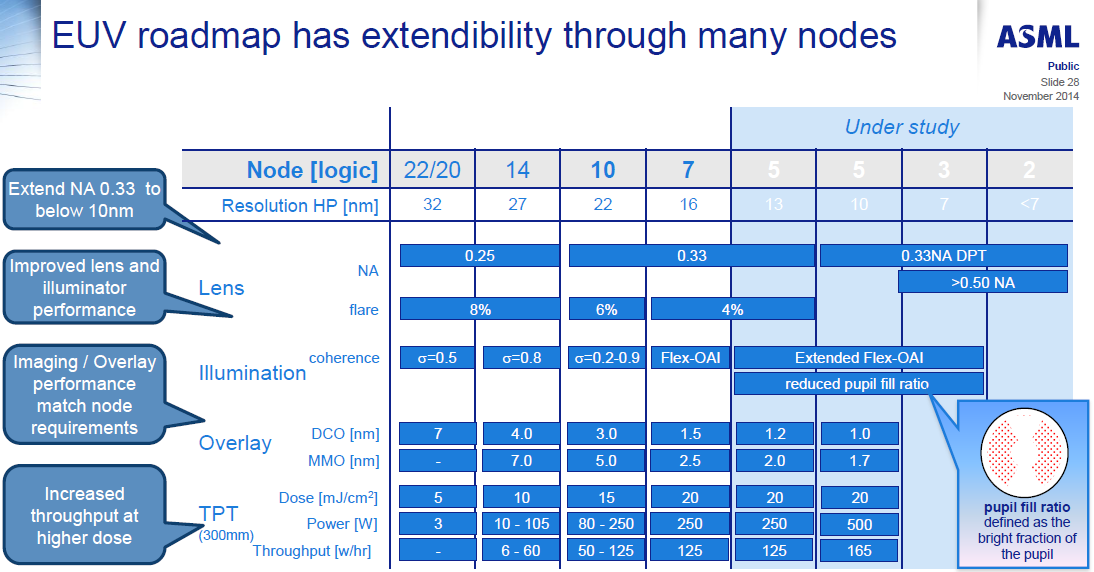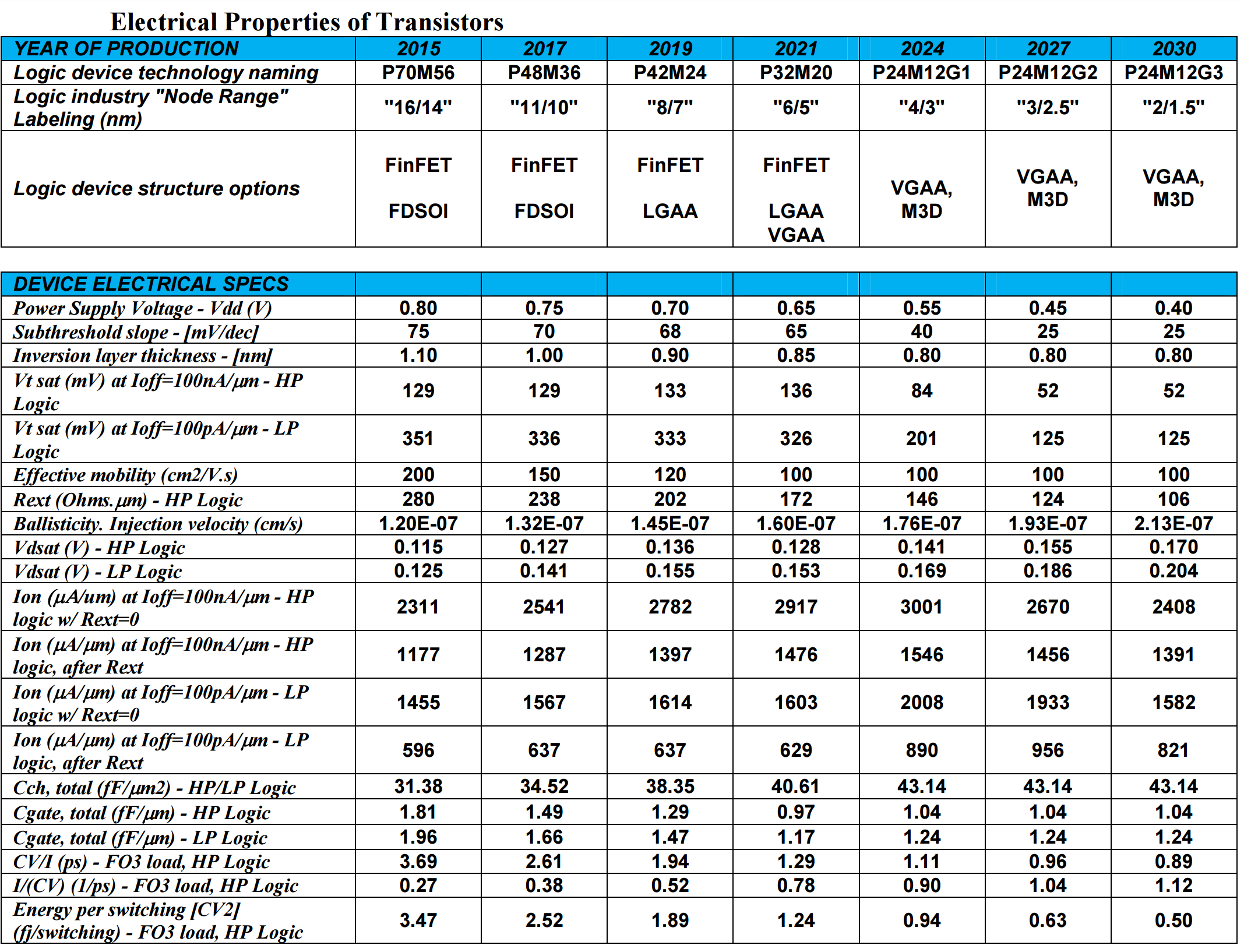Ten Year Anniversary of Core 2 Duo and Conroe: Moore’s Law is Dead, Long Live Moore’s Law
by Ian Cutress on July 27, 2016 10:30 AM EST- Posted in
- CPUs
- Intel
- Core 2 Duo
- Conroe
- ITRS
- Nostalgia
- Time To Upgrade
Looking To The Future: 450mm Wafers in 2021, and Down to ‘2nm’
Most users following the industry will know that the name of the lithographic node, such as ‘14nm’, ‘16nm’ or ‘28nm’ is often an imperfect characterization of what is actually happening on the silicon. For example, Intel’s 14nm node is widely touted as the best in the industry, and the equivalent 14nm/16nm nodes are said to not be even close, due to Intel’s focus on several generations of FinFET compared to the other main semiconductor manufacturers. This also means that while ‘14nm’ or ‘16nm’ is mentioned, many other parts of the silicon could be manufactured on other nodes, depending on the utility.
We’ve spoken in the past about equipment roadmaps to deal with the problem of shrinking lithography node sizes. This includes new lasers, droplet generation, collectors, masks, defect detection, lenses, and the technology to drive high throughput. For example, here are ASML’s EUV requirements for the next few manufacturing nodes, including requirements for 250W light sources at a 5nm node:
With the ITRS report, it makes a couple of metrics regarding node sizes and wafers. On the later, we get the prediction that 450mm wafers should be in play at around 2021 for DRAM:
This matches at DRAM half-pitch of 15nm, or a DRAM cell size of 780nm2, compared to 3480nm2 today. The movement to 450mm wafers has been expected for some time, with early predictions going for the 2008-2011 timeframe, however development seems to have stalled for a variety of reasons.
When it comes to transistors, given the node naming scheme caveats listed above, the ITRS report predicts that FinFET will make way at around the 2021 timeframe in favor of 3D stacking such as ‘vertical gate all-around’ (VGAA). As the node shrinks, as well as the transistor size, the power supply voltage will drop from 800mV today down to 400/450mV by 2027.
Moving into a world of IoT will require even lower power transistors, of which moving to a ‘smaller node’ and vertical chip integration will be a large part.
The ITRS report goes into a lot of detail regarding different stacking technologies, such as the 2.5D integration we see on products like AMD’s Fiji GPU involving a silicon interposer, as well as 3D and the different ways to implement both microchannel cooling in such chips as well as 3D TSV applications.













158 Comments
View All Comments
e1jones - Wednesday, July 27, 2016 - link
My E8400 is still my daily driver, 4x 2gb and an SSD swapped in later as the boot drive. Still runs great, except it tends to get bogged down by the TrustedInstaller and the Firefox memory leaks.rarson - Friday, August 5, 2016 - link
I've got an E8600 in an Abit IP35 Pro motherboard. I was having a hard time finding DDR2-1066 last I looked, so I settled for 800. With an SSD and 7870, it's surprising how well it still games. I don't think I'll upgrade the GPU again just due to the fact that I'm limited to PCI-e 2.FourEyedGeek - Monday, August 8, 2016 - link
You could get a higher end GPU and still benefit from increased performance, then get a new CPU motherboard combo when you want too.BrokenCrayons - Wednesday, July 27, 2016 - link
I just upgraded out of a Q6600 and 4GB DDR2 about 2 months ago and I admit that I was still kicking around the idea of leaving it alone as I was pulling the motherboard out of the case. I replaced it with a cheap AMD 860k and 16GB DDR3 which really hasn't done a lot to improve the system's performance. In retrospect, I think I could realistically have squeezed another couple of years out of it, but the motherboard's NIC was iffy and I really wanted reliable ethernet.As for laptops, I've got a couple C2Ds kicking around that are perfectly adequate (T2310 & P8400) for daily use. I really can't see any point in replacing them just yet. Core was a good design through all its iterations.
Beany2013 - Wednesday, July 27, 2016 - link
I like your style - rather than drop $100 on a midlevel intel NIC, you replace an entire platform.I strongly approve of these economics :-)
Michael Bay - Thursday, July 28, 2016 - link
USB3 is kind of nice.BrokenCrayons - Thursday, July 28, 2016 - link
Well the NIC wasn't the only reason, but it was the last in a series of others that I was already coping with that tipped the scales. The upgrade was under $200 for the board, processor and memory so it really boiled down to one weekend dinner out to a mid-range restaurant. It was worth it for more reliable Steam streaming and fewer VNC disconnects as that wired ethernet port is the only means by which I regularly interact with my desktop since it has no monitor and is crammed into a corner in my utility room.artk2219 - Friday, July 29, 2016 - link
Why didn't you go for an FX if you dont mind me asking? You liked the FM2+ platform a bit better?BrokenCrayons - Friday, July 29, 2016 - link
Actually, I didn't give much of anything in the system a very close look before buying. I admittedly did about twenty minutes of research to make sure the 860k and the bottom feeder motherboard I'd picked would play nicely together before making a purchase. So the CPU & motherboard pair were the result of laziness and apathy rather than a preference for FM2+.artk2219 - Monday, August 1, 2016 - link
Ah ok gotcha, I just wanted to share that if you had a microcenter near you they sell FX 8320E's bundled with motherboards for 125 to 170 depending on which board you want to use. That can be quite the steal and a great base for a new cheap system once you bump the clocks on the 8320E.